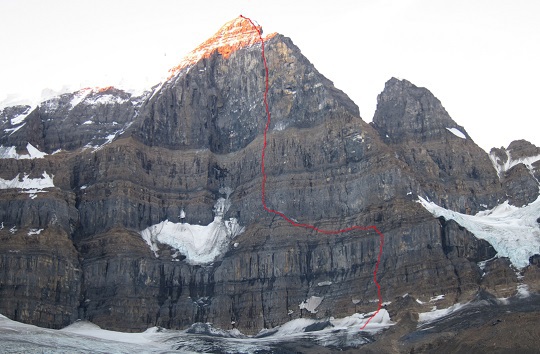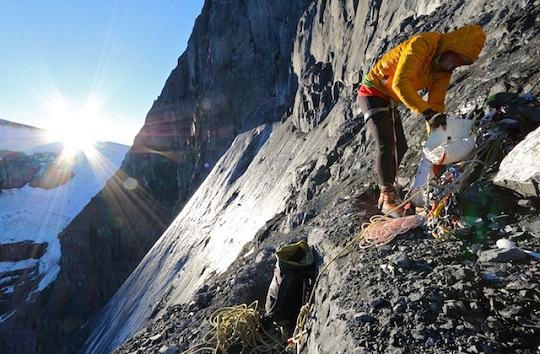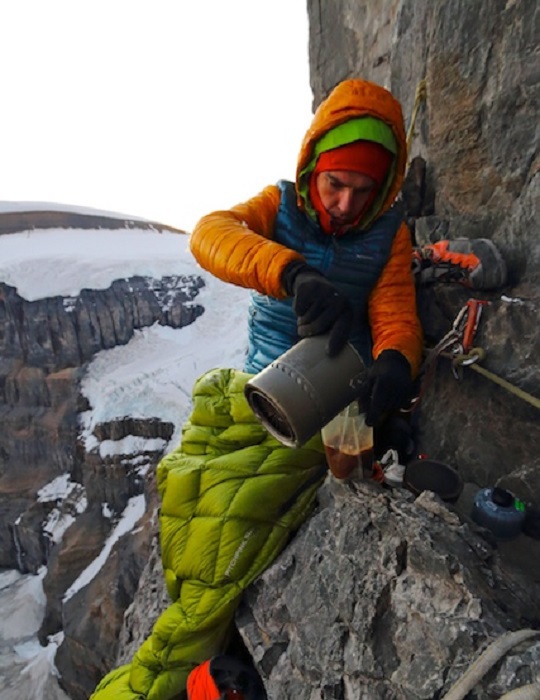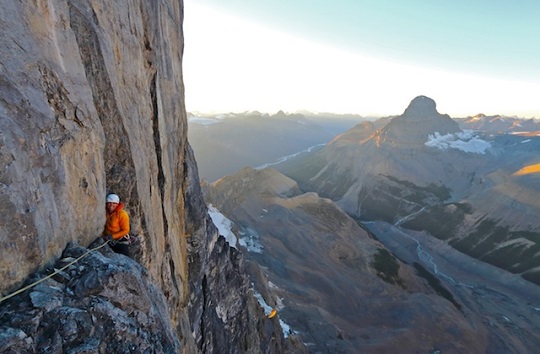
With only three ascents in 29 years, by the likes of George Lowe, Barry Blanchard and Steve House, the North Face of Twins Tower is one of the most storied walls in the Canadian Rockies. On September 15, Canadian Jon Walsh and American Josh Wharton completed the second ascent of the North Pillar (5.10 A2, 1500m) of Twins Tower, a sub-peak of North Twin (12,200′), “A mountain archetype,” as Steve House describes in Alpinist 8. “[I]t bursts skyward from the very belly of the earth, gaining breadth with height and then like a stone wave turning concave and slim and sharpening to its bifurcated crest.”
The route, considered to be the most technical and sustained line up the North Face, was pioneered by Barry Blanchard and David Cheesmond in 1985. “It seemed like we were right on the edge of our risk tolerance levels the entire time, and perhaps even crossed the line,” Walsh wrote on his blog, “Staying on that edge for such an extended time was exhausting!” At 4,500 feet, the North Face is the biggest face in the Canadian Rockies. “That’s definitely part of the appeal to it,” Walsh said recently regarding his motivation to climb the North Pillar with Wharton. The duo climbed the route in well over 30 pitches.

Since the Grade VI North Face was first climbed at 5.10 A3 in 1974 by George Lowe and Chris Jones, only three other teams have summited the immense wall, the low success rate a result–at least in part–of extensive rockfall and wet conditions. Steve House and Marko Prezelj completed the wall’s only ascent in winter conditions in April 2004. During the 1985 ascent, Blanchard and Cheesmond experienced dangerously loose rock. Blanchard recalled on his blog, “A five foot by two foot by one foot thick hunk of rock sheared away from the side of the number 3 Friend that I was jumaring on. It roared out over me, a revolving black shadow.” Luckily the backup nuts held. “It was mind boggling to us, that the only three parties to have climbed the face previously had done so in 1974, 1985, and in [April] of 2004. All parties had been pushed to their mental and physical limits, including ourselves,” Walsh wrote.

Both Walsh and Wharton had previously been to the wall. Walsh attempted the face in 2011 with Canadian Jason Kruk (who was thwarted on the climb earlier in the year by bad weather while climbing with American Hayden Kennedy), but retreated when a block dislodged and crushed Walsh’s foot. The injury forced the team to endure an open bivy before making a difficult retreat the following day. Also in 2011, Wharton hiked in, only to find the route too wet to climb.
A low snow year and a hot summer yielded prime conditions on the face this season. Nonetheless, Walsh and Wharton completed the ascent with a meager amount of food. Having planned to use rations stockpiled during Wharton’s visit to the wall two years prior, the pair skimped on food supplies. However, after someone cleaned out the stash, the two suffered. “On the fourth day we woke up to a bite of granola and that was it. I’m still feeling skinny,” Walsh said afterward. “We’re not mad at the guys who did it. We blame ourselves for not bringing in enough extra food.”

The project took the team five days to complete, with one day spent on the approach and three days spent on-route. During Walsh and Wharton’s ascent they “followed free. Always. We never did any ascending,” Walsh said. The descent required extensive down climbing, often unroped.
Wharton wrote of the route, “This was my first ‘summer’ conditions climb in the Rockies, so I was a bit shocked by just how much loose rock there was…I expected it to be bad, but it was really bad. There was a time early on in the climb where I definitely questioned whether the risks involved with climbing the wall were worth it…”
The route contains everything from tall creaking pillars to what Walsh called “portable holds, holds that can sometimes surprise you and cause you to fall. You can’t move fast up there. You can’t gun it. It’s delicate.”

During the climb, Walsh encountered one scary moment, recalling, “I was 15 to 20 meters above the belay. I had to climb up this tower of rubble to get to this next crack. My bigger gear was lower down, and I only had two micronuts in. It was 5.11 climbing, and I ended up down climbing like eight meters to a ledge and made an anchor and then pulled the rope so Wharton wouldn’t have to climb off the micronuts. I didn’t even want to commit body weight to them. It was spicy all the time. There are many times you have to trust in your own skills and instincts.”
Walsh has no plans to repeat the wall, as he states, “I don’t do the big routes in the Rockies that I’ve already done. Once is enough.” Adding in his blog, “Hardest route in the Rockies??? Maybe….”